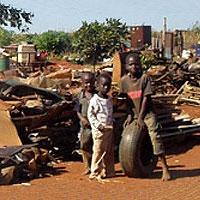KENYA: Thousands displaced in Molo need aid – officials

Tensions are high in Kenya's New Molo District, Rift Valley province, where ethnic clashes have resulted in 15 deaths and 16,000 villagers displaced since October, an official of the Kenya Red Cross Society (KRCS) said on 6 December.
"Those displaced are sleeping in the open and catching pneumonia and other respiratory tract infections because of the prevailing cold weather," Dr James Kisia, the deputy secretary-general of the KRCS, told IRIN.
The most affected areas are Kuresoi, Keringet and Olengurone divisions of New Molo, Kisia said. Several people have been injured, some admitted to hospital, and at least 200 houses in these areas have been burnt.
"People cannot access their farms, the sanitation facilities in areas where they have sought refuge are stretched; some are even consuming untreated water from a nearby river," he said. "Even though we are distributing food and non-food items to the displaced, there is a huge gap as we lack the funds to cover all the displaced."
Josephat Wafula, the KRCS coordinator for Nakuru district, said at least 200 families had arrived in Molo town and most had sought refuge at a church compound.
"There have been no reports of overnight [5-6 December] violence but we have received reports of houses having been torched," he said.
On 5 December, the KRCS declared the situation in New Molo a humanitarian crisis and appealed for funds to help those affected.
According to the KRCS, the clashes are politically instigated and pit three ethnic communities against one another.
Analysts and political observers trace the root of the violence to Kenya's colonial era when, in 1941, the government settled 4,000 squatters in Olengurone to work in white-owned plantations and farms nearby. Clashes in the area since the 1990s have pitted descendants of these squatters against other local communities settled in the area.
An analyst said these villagers had since become pawns in political games of politicians who, every election year, incite their supporters to evict their neighbours, promising them land left behind by those who flee.
Newspaper reports on 6 December indicated that police had arrested 102 people over the violence and that 60 others had been charged in courts since the start of the clashes.
Kisia said the violence seemed cyclical, intensifying mostly during election years. A general election in Kenya is scheduled for 27 December.
"Tension is high on the ground, with continued lack of trust between the communities living in the affected areas," KRCS said its latest bulletin. "Initially the clashes had been concentrated in Kuresoi area, but there seems to an escalation in the adjacent divisions of Keringet. The displaced families are camping in the town centre, police stations, the DO's [district officer's] office and churches."
KRCS said maize, beans and potato farms that were ready for harvesting had been abandoned. "The crops will eventually be wasted in the farms, which will lead to prolonged suffering of the affected population."
At a camp for the displaced at Keringet, KRCS said, water and sanitation facilities were over-stretched, with the displaced using water from shallow wells and few from taps.
"About 400 people are camping at the Keringet police post, the majority of whom are women and children under the age of five years," KRCS said. "There are only three pit latrines and one borehole. The IDPs are consuming untreated water from nearby streams."
Patrick Nyongesa, the KRCS regional manager for the North Rift, said the Kenyan government had given maize, beans and cooking oil for distribution to the affected villagers but that further intervention was required.
"Due to the tension, it looks like the situation will remain this way for some time and we need to provide food and non-food assistance to the displaced," he said.
 Back and Next - Back and Next
Back and Next - Back and Next See Also - See Also
See Also - See Also